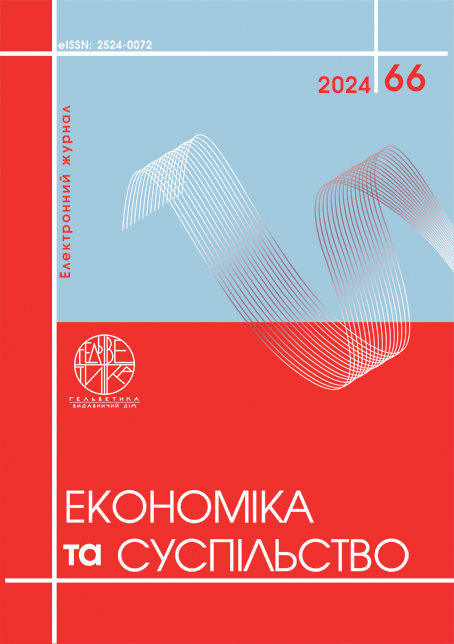INTEGRATION OF INNOVATIVE MANAGEMENT PRACTICES INTO THE ANALYSIS OF ENTERPRISE ORGANIZATIONAL STRUCTURES
Abstract
The article explores the current issue of building and optimizing organizational structures of enterprises to enhance their efficiency in the context of dynamic business development and globalization. Special attention is given to the integration of innovative management practices, such as Agile and Scrum, into the analysis of organizational structures. It is determined that in the modern business environment, characterized by constant changes and high competition, traditional linear and hierarchical structures become less effective. To survive and thrive in such conditions, organizations need to quickly adapt their internal processes and structures to new challenges. It has been proven that flexible methodologies, such as Agile and Scrum, provide companies with the ability to respond promptly to external challenges by delegating authority to lower management levels and forming autonomous, cross-functional teams. This helps to avoid excessive bureaucracy and accelerates the decision-making process. It is identified that teams working with Agile methodologies focus on rapid iterations and continuous improvement, which enhances the quality of tasks performed and better adapts to customer requirements. The article also examines the key principles of organizational structure building: unity of purpose, division of labor, hierarchy, centralization and decentralization, responsibility, adaptability, and cost-effectiveness. A detailed analysis is conducted on how the integration of innovative management practices can influence each of these principles and improve the overall efficiency of the organization. The research results indicate that the application of flexible management practices not only enhances employee productivity and motivation but also enables companies to be more competitive in the market by increasing flexibility and speed in responding to changes. The article emphasizes the importance of customer orientation, which is fundamental to achieving success in the modern business environment. It is concluded that the integration of innovative approaches into the organizational structures of enterprises is a crucial tool for improving their efficiency and ability to quickly adapt in the context of globalization and constant change.
References
Леонов О., Леонова Т. Теорія організації та організаційні структури сучасного корпоративного управління. Економіка та суспільство, Вип. 54. 2023. DOI: https://doi.org/10.32782/2524-0072/2023-54-4
Свінарьова Г.Б., Філіпова С.В. Розвиток підходів щодо формування організаційних структур підприємства на засадах гнучкого управління. Економіка: реалії часу. Науковий журнал. 2021. № 2 (54). С. 87-91. DOI: https://doi.org/10.15276/ETR.02.2021.11. DOI: https://doi.org/10.5281/zenodo.5527150
Кудінова М. М., Рибалка А. С., Чубач О. Р. Підвищення ефективності управління підприємством шляхом удосконалення організаційної структури. Східна Європа: бізнес та управління. 2018. Випуск 3 (14). С. 199-205.
Спільниченко М., Носань Н.С. Сутність та принципи Agile-менеджменту в управлінні проектами на сучасному підприємстві. Інфраструктура ринку. Вип. 77. 2024. С. 97-100. DOI: https://doi.org/10.32782/infrastruct77-17
Завербний А.С., Ільницький В.С. Вплив організаційних структур управління на ефективність використання гнучких методологій управління проєктами при виробництві технологічних продуктів. Електронне наукове фахове видання з економічних наук «Modern Economics», №23. 2020, с. 69-73. URL: https://modecon.mnau.edu.ua
Копішинська К. О. Використання Agile-менеджменту в управлінні інноваційними процесами. БІЗНЕСІНФОРМ. 2016. № 11. С. 344-349.
Leonov O., Leonova T. (2023) Teoriya orhanizatsiyi ta orhanizatsiyni struktury suchasnoho korporatyvnoho upravlinnya [Theory of organization and organizational structures of modern corporate management]. Ekonomika ta suspilstvo, vol. 54. DOI: https://doi.org/10.32782/2524-0072/2023-54-4
Svinarova H.B., Filipova S.V. (2021) Rozvytok pidkhodiv shchodo formuvannya orhanizatsiynykh struktur pidpryyemstva na zasadakh hnuchkoho upravlinnya [Development of approaches to the formation of organizational structures of the enterprise on the basis of flexible management]. Ekonomika: realiyi chasu. Naukovyy zhurnal. vol. 2 (54). Р. 87-91. DOI: https://doi.org/10.15276/ETR.02.2021.11. DOI: https://doi.org/10.5281/zenodo.5527150
Kudinova M. M., Rybalka A. S., Chubach O. R. (2018) Pidvyshchennya efektyvnosti upravlinnya pidpryyemstvom shlyakhom udoskonalennya orhanizatsiynoyi struktury [Increasing the efficiency of enterprise management by improving the organizational structure]. Skhidna Yevropa: biznes ta upravlinnya. vol. 3 (14). Рр. 199-205.
Spilnychenko M., Nosan N.S. (2024) Sutnist ta pryntsypy Agile-menedzhmentu v upravlinni proektamy na suchasnomu pidpryyemstvi [The essence and principles of Agile management in project management at a modern enterprise]. Infrastruktura rynku. vol. 77. Рр. 97-100. DOI: https://doi.org/10.32782/infrastruct77-17
Zaverbnyy A.S., Ilnytskyy V.S. (2020) Vplyv orhanizatsiynykh struktur upravlinnya na efektyvnistʹ vykorystannya hnuchkykh metodolohiy upravlinnya proyektamy pry vyrobnytstvi tekhnolohichnykh produktiv [The influence of organizational management structures on the effectiveness of the use of flexible project management methodologies in the production of technological products]. Elektronne naukove fakhove vydannya z ekonomichnykh nauk «Modern Economics», vol. 23. р. 69-73. URL: https://modecon.mnau.edu.ua
Kopishynska K.O. (2016) Vykorystannya Agile-menedzhmentu v upravlinni innovatsiynymy protsesamy [The use of Agile management in the management of innovative processes]. BIZNESINFORM. vol. 11. S. 344-349.

This work is licensed under a Creative Commons Attribution 4.0 International License.


